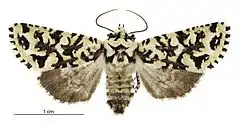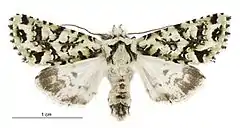Meterana exquisita
Meterana exquisita is a species of moth in the family Noctuidae. This species is endemic to New Zealand. It is classified as "At Risk, Relict'" by the Department of Conservation.
| Meterana exquisita | |
|---|---|
 | |
| Female | |
 | |
| Male | |
| Scientific classification | |
| Kingdom: | |
| Phylum: | |
| Class: | |
| Order: | |
| Family: | |
| Genus: | |
| Species: | M. exquisita |
| Binomial name | |
| Meterana exquisita | |
| Synonyms[2] | |
| |
Taxonomy
This species was first described and illustrated by Alfred Philpott in 1903 and was given the name Melanchra exquisita.[1] Philpott used a male specimen he collected at West Plains in Southland in December.[3] George Hudson discussed and illustrated this species in his 1928 book The Butterflies and Moths of New Zealand.[4] In 1988 John S. Dugdale placed this species within the genus Meterana.[2] The hototype specimen is held at the New Zealand Arthropod Collection.[2]
Description
The larvae of this species are large, angular and green coloured with thin red and white lines.[5]
Philpott originally described the male of the species as follows:
♂︎. 32 mm. Head and palpi greenish ; tips of palpi and outward surfaces blackish ; two linear black marks on crown of head. Antennae brownish, shortly bipectinated. Legs greenish, annulated with black. Thorax with moderate bifid anterior and posterior crest ; green, with black irregular V-shaped mark, the apex towards head. Abdomen dull-yellowish, anal segments black ; also blackish on sides of segments, and dorsal series of black spots. Fore wings : Costa almost straight, apex rounded ; termen not crenulate, obliquely rounded, bright-green, black suffusion from base obliquely towards dorsum, terminating in oblique black white-margined upwardly bent projection at 1⁄4; distinct white irregularly black-margined line from costa near base to black suffusion, irregular interrupted white -margined black line from about 1⁄4 of costa to before 1⁄2 of dorsum, several irregular projections at middle of wing, and upper half of line forked ; irregular black outwardly white-margined band at 1⁄2, outwardly oblique to middle of wing, thence inwardly oblique to dorsum, on which broadly and irregularly clavate ; costa with alternate black and white dots ; reniform spot obscurely outlined in black, edged with white ; dentate black line beyond reniform, indentations filled with white ; strong subterminal black line, interrupted above and below middle, broadly and suffusedly white-margined. Cilia green, barred with black, and with an indistinct darker line. Hind wings pale greenish-yellow, with brownish suffusion on apical portion ; an irregular line at 2⁄3 , and discal spot of same colour. Cilia pale-green.[3]
Distribution
This species is endemic to New Zealand.[6] M. exquisita has occurred in Auckland, Waikato, Taupo, Whanganui, Wairarapa, Nelson, South Canterbury, Mackenzie country, Central Otago, Otago Lakes and Southland.[7] However this species is now locally extinct in its type locality of West Plains and is almost wiped out in Auckland.[7]
Life cycle and behaviour
This species has only one generation a year.[8] The larvae are bright green coloured and as a result are well camouflaged when feeding on their host species.[8] Larvae feed for one month before they pupate.[8] M. exquisita are on the wing from August to December but are most common from September to October.[8] The species can fly for at least 800m from their nearest host plant.[5] This species has been collected at sugar traps.[3]
Host species and habitat

The plant host species for the larvae of M. exquisita are small-leaved Olearia species.[7][8] These include O. hectorii, O. odorata,[7] and O. bullata.[9]
Conservation status
This moth is classified under the New Zealand Threat Classification system as being "At Risk, Relict".[10] One of the reasons for this classification is that the habitat of this species is under threat from land development.[7] The elimination of the host plants of this species has resulted in their extinction from sites in New Zealand.[8]
References
- "Meterana exquisita (Philpott, 1903)". www.nzor.org.nz. Landcare Research New Zealand Ltd. Retrieved 2018-05-17.
- Dugdale, J. S. (1988). "Lepidoptera-annotated catalogue, and keys to family-group taxa" (PDF). Fauna of New Zealand. 14: 207 – via Landcare Research New Zealand Ltd.
- Philpott, Alfred (1903). "On some new species of Lepidoptera (moths) from Southland". Transactions and Proceedings of the New Zealand Institute. 35: 246–249 – via Biodiversity Heritage Library.
- Hudson, G. V. (1928). The Butterflies and Moths of New Zealand. Wellington: Ferguson & Osborn Ltd. p. 63.
- Pawson, S.M.; Emberson, R.M. (2000). "The conservation status of invertebrates in Canterbury" (PDF). Conservation Advisory Science Notes. 320: 1–64.
- Gordon, Dennis P., ed. (2010). New Zealand inventory of biodiversity. Volume two. Kingdom animalia : chaetognatha, ecdysozoa, ichnofossils. Vol. 2. Christchurch, N.Z.: Canterbury University Press. p. 461. ISBN 9781877257933. OCLC 973607714.
- Patrick, Brian; Dugdale, John S. (2000). Conservation status of the New Zealand lepidoptera (PDF). Wellington, N.Z.: Department of Conservation, New Zealand. p. 32. ISBN 0478218672. OCLC 154670803.
- Patrick, Brian (2000). Lepidoptera of small-leaved divaricating Olearia in New Zealand and their conservation priority (PDF). Wellington, N.Z.: Department of Conservation, New Zealand. ISBN 0478220154. OCLC 48661253.
- Lambert, Michelle Teresa (2015). "Ecology of the declining Olearia lineata and not-threatened Olearia bullata in human-modified environments and implications for their conservation" (PDF). www.ir.canterbury.ac.nz. Retrieved 18 May 2018.
- Hoare, R.J.B.; Dugdale, J.S.; Edwards, E.D.; Gibbs, G.W.; Patrick, B.H.; Hitchmough, R.A.; Rolfe, J.R. (2017). Conservation status of New Zealand butterflies and moths (Lepidoptera), 2015 (PDF). Wellington, New Zealand: New Zealand Department of Conservation. p. 8. ISBN 9781988514383.
External links
| Wikimedia Commons has media related to Meterana exquisita. |
| Wikispecies has information related to Meterana exquisita. |